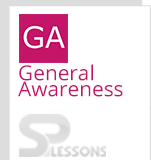 Introduction
Introduction
India, the land of ancient civilization has a dynamic history spanning back to the beginning of human civilization. Indian History began with the birth of Indus Valley Civilization also popularly known as Harappan Civilization. Harappan Civilization flourished around 2500 BC. The prime occupation during the times was agriculture and domesticating animals and making tools and weapons from copper, bronze & tin.
Indian History is an important topic in General Awareness. Indian History Practice Quiz article, is exceedingly important for candidates preparing for RRB ALP/Technical Exams/Junior Engineer Recruitment, SSC CGL, UPSC (Civil services exam including IAS) Exams and other government sector recruitment exams. The article Indian History Practice Quiz, will assist the students understanding of the type of questions expected from the topic Indian History.
 Quiz
Quiz
1. Which one of the following leaders was elected as President of the All India Khilafat Conference held in Delhi in 1919?
- A. Mahatma Gandhi
B. Shaukat Ali
C. M.A. Jinnah
D. None of these
- A. Swadeshi Movement
B. Home Rule Movement
C. Civil Disobedience Movement
D. Civil Disobedience Movement
- A. Capturing Legislature Councils by contesting elections
B. Boycotting the elections
C. Overthrow of Government by organizing a country wide strike
D. None of these
- A. Maulana Shaukat Ali
B. Maulana Muhammad Ali
C. M.A. Jinnah
D. Maulana Abdul Kalam Azad
- A. Sardar Bhagat Singh
B. Khudiram
C. B.K. Dutt
D. All these
- A. Maulana Mohmmed Ali
B. Hasan Imam and Mazhar-ul Haque
C. Agha Khan and Mohsinul-Mulk
D. Hakim Ajmal Khan and Zafar Ali Khan
- A. W. Wedder-burn
B. A.O. Hume
C. George Yule
D. Mrs. Annie Besant
- A. Hakim Ajmal Khan
B. Rafi Ahmad Kidwai
C. Abul Kalam Azad
D. Badruddin Tayabjee
- A. Women
B. Peasants
C. Students
D. Muslims
- A. European indigo planters
B. Mill owners of Ahmedabad.
C. British government to protest against the Rowlatt Acts
D. Racist authorities of South Africa.
- A. Fearlessness
B. Truthfulness
C. Non-violence
D. All of these
- A. Ahmedabad
B. Champaran
C. Sabarmati
D. Bardoli
- A. The security of rights of Harijans
B. Civil disobedience movement
C. Maintaining the unity of Hindu society
D. Solving the problem of the indigo workers
- A. Nauroji
B. Gokhale
C. Tilak
D. Lala Lajpat Rai
- A. Jawaharlal Nehru
B. Mahatma Gandhi
C. Lala Lajpat Rai
D. Subhash Bose
1. Ashoka in the 13th year of his coronation, appointed a special type of officer who surveyed the land, kept land records and carried out justice. These officers were called
- A. Amatyas
B. Samahartas
C. Rajukas
D. Chalukyas
- A. Anantavarmana Chodaganga
B. Narsimahavarmana
C. Aadiyavarmana
D. Parmeshwaravarmana
- A. Communal Harmony
B. Sexual Aggression
C. Company's Act
D. Information Technology
- A. Ahmedabad strike, 1918
B. Rowlatt Satyagraha, 1919
C. Swadeshi Movement, 1905
D. Champaran Satyagraha, 1917
- A. Harshavardhan
B. Chandragupta II
C. Ashoka
D. Kanishka
- A. Akbar
B. Jahangir
C. Shah Jahan
D. Aurangzeb
- A. 1920 A.D.
B. 1930 A.D.
C. 1942 A.D.
D. 1946 A.D
- A. Kautilya
B. Kalidasa
C. Shudraka
D. Megasthenes
- A. Punjab
B. Uttar Pradesh
C. Assam
D. Maharashtra
- A. Jyotiba Phule
B. G.K. Gokhale
C. B.G. Tilak
D. B.R. Ambedkar
- A. Kusinagar
B. Sarnath
C. Pataliputra
D. Vaishali
- A. Lord Chelmsford
B. Lord Dalhousie
C. Lord Dufferin
D. Lord Canning
- A. Bhulabhai Desai
B. Asaf Ali
C. Subhash Chandra Bose
D. C. Rajagopalachari
| Column. A | Column. B |
|---|---|
| P. Bihu | 1. Gujarat |
| Q. Garba | 2. UP |
| R. Tamasha | 3. Assam |
| S. Nautanki | 4. Maharashtra |
- A. P-4, Q-1, R-2, S-3
B. P-3, Q-1, R-4, S-2
C. P-3, Q-1, R-2, S-4
D. P-1, Q-4, R-2, S-3
- A. Delhi
B. Mumbai
C. Kolkata
D. Madras
1. "Khalsa" was founded by-
- A. Guru Gobind Singh
B. Guru Ramdas
C. Guru Nanak
D. Guru Arjun Dev
- A. Vyasa
B. Kalidasa
C. Tulsidasa
D. Valmiki
- A. Berar
B. Ahmad nagar
C. Golconda
D. Mysore
- A. Raja Ram Mohan
B. Gopal Krishna Gokhale
C. Swami Dayanand Saraswati
D. Anne Besant
- A. 1835
B. 1857
C. 1892
D. 1905
- A. Plassey
B. Buxar
C. Talikota
D. Wandiwash
- A. 1857
B. 1853
C. 1818
D. 1854
- A. Swadeshi Movement
B. Non-Cooperation Movement
C. Civil Disobedience Movement
D. Quit India Movement
- A. Dandi
B. Kheda
C. Pochampalli
D. Champaran
- A. Akbar
B. Jahangir
C. Shahjahan
D. Aurangzeb
- A. Awadh
B. Jhansi
C. Satara
D. Nagpur
- A. Bhavnagar, Gujarat
B. Ujjain, Madhva Pradesh
C. Nasik, Maharashtra
D. Varanasi, Uttar Pradesh
- A. Punjab
B. Rajasthan
C. Madhya Pradesh
D. Bihar
- A. Delhi
B. Calcutta
C. Bombay
D. Surat
- A. attainment of Self-Government was declared as the objective of the Congress
B. attainment of Poorna Swaraj was adopted as the goal of the Congress
C. Non-Cooperation Movement was launched
D. decision to participate in the Round Table Conference in London was taken



